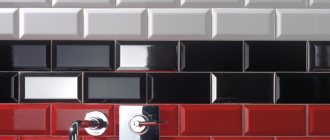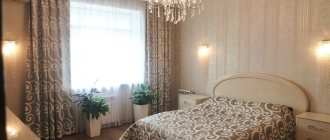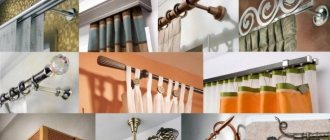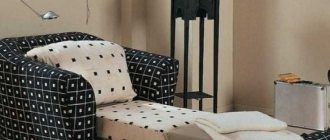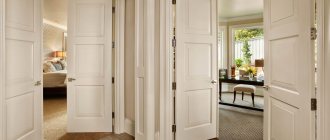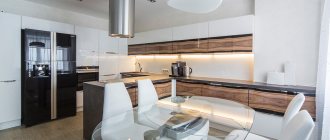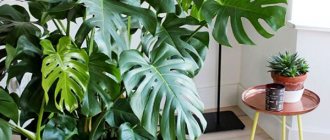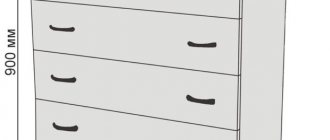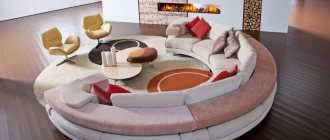Currently, there are many options for ceiling coverings. Finishing the ceiling with MDF panels is a fairly popular solution. This is due to the advantages that this simple, accessible and cost-effective material provides. Its excellent performance properties make it possible to maintain a presentable appearance for a long time.
Definition of MDF panel
It’s a common thing when, during renovations in apartments or houses, it is discovered that the ceiling is uneven or the joints of the panel slabs do not match perfectly. This situation can be corrected using a suspended ceiling. The ceiling made of MDF panels takes a well-deserved place among the huge selection of suspended ceilings.
MDF panel is a fibreboard (fibreboard) produced by dry pressing of small wood chips using high pressure and temperature with urea resins modified with melamine.
Important! In the production of MDF panels, no adhesive resins that are harmful to health are used.
Criteria for choosing plastic panels
Covering the ceiling with plastic panels will have the desired result only if the finishing material is chosen correctly. To do this, it is recommended to adhere to the following tips:
- stiffeners must be free of visible damage and deformation
- the design on the façade should be distinct, with clear lines, without blurred areas
- the coating of all selected panels must have the same tone, for this the panels must be from the same batch
- there should be no dents or scratches on the plastic
- do not buy panels of different sizes
Types of MDF panels
They can be of several types, depending on the pricing policy:
- Veneered – during production, natural veneer from valuable trees is used, so the coloring is always “wood-like”. But they always look original and rich. Outwardly they look like natural wood, but, unlike wood, they are relatively moisture resistant, will not dry out or warp, and therefore are more durable. This is the most expensive type of MDF panels.
- Laminated – using the cold lamination method, a polymer film (PVC) is applied to the outer layer of the panel, which will resist moisture. Thanks to the pattern of the film, they will look, for example, like marble or wood. The color can be different, glossy or matte. Additional advantages include antistatic properties and resistance to direct sunlight.
- Painted – colors can be different, glossy or matte. High-quality paints withstand chemical attack. Their disadvantage is that they do not have a protective film, which means they are not moisture resistant.
- Paper coated – the plate is covered with paper. Of course, they are not intended for rooms with high humidity, but in the corridor on the ceiling they can serve. Accordingly, they have the lowest price.
The front side appearance may look like this:
- flat - covered with PVC or wood veneer;
- relief - is a panel with a cut-out pattern, covered with paint and varnish material.
There is a classification according to size:
- rack - reminiscent of building material - lining;
- tiled - in the form of square tiles;
- sheet - large sheets with a pattern.
Interestingly, MDF panels were first produced industrially in the USA in the late 60s of the 20th century. The Russian manufacturer launched production in the late 90s.
Varieties of products depending on size
Rectangular PVC Ceiling Plate
One of the most important factors that must be taken into account when choosing plastic cladding is their size, which varies depending on the width of the slabs.
Plastic products presented on the modern market can be divided into three groups:
- Tiled type;
- Plastic lining;
- Sheet plastic.
Products included in one group or another differ in size, cost, level of rigidity and weight.
Important! The external perception of the interior design and the type of finishing work depend on the size and other parameters of the lamellas.
Plastic lining
The parameters of the standard thickness of products vary from 0.5 to 1 cm, which must be taken into account when purchasing molding in the form of a decorative overlay strip, which is the final element and decoration in the interior. As for the length of products, ceiling ones can reach 3 meters.
Standard sizes of PVC products
Structurally, PVC cladding is classified as follows:
- “European” or eurolining is characterized by a length of up to 3 m with a standard width of 10 cm and a wide locking system;
- “Polka” has the same parameters, but a narrow locking system;
Types of plastic lining
- Reinforced lining can be distinguished from others by its double profile and width of 12.5 cm;
- The tiled elements are square in shape without a locking system;
Tile type PVC wall panels
- Expanded panels include elements with a width from 15 to 50 cm and a length of 2.6/2.7/3 m;
- Sheet plastic products often have a mosaic design and are used for wall cladding. They are not equipped with a locking system and can be quite large – from 0.8 to 2.03 m in width and from 1.5 to 4.05 m in length.
Two- and three-section linings with metallized or colored inserts are highly decorative.
Slab in the form of a three-section lining
Pros and cons of MDF panels for ceiling finishing
Any finishing material has its positive and negative sides. Familiarization with the performance characteristics when choosing a finishing material will help everyone make the right decision. As for MDF panels, the advantages, in this case, outweigh the disadvantages, which will allow you to make the right choice by choosing MDF panels for the ceiling.
So, the advantages of the material:
- Environmentally friendly material . MDF panels are a medium-density wood fiber board. Made from natural wood chips by pressing at high temperatures. The composition does not include phenol and toxic resins, which means that no harmful fumes will be released during operation.
- Cost-effective material . The low price makes this ceiling option popular.
- Practicality. Application extends not only to residential, but also office or industrial premises.
- Noise insulation . They perfectly absorb “noise from above”, which, in itself, is especially important in multi-storey buildings. Moreover, during the installation process it is possible to enhance this effect with the help of additional soundproofing materials.
- Thermal insulation . The density of the compressed material does not allow “cold from above” to pass through and does not release “heat from below”, which is important for apartments on the upper floors.
- Resistant to temperature changes . They do not react to either cold or heat.
- Strength and durability . Thanks to their ability to resist environmental influences, they have a long service life, while still remaining attractive in appearance.
- Easy to install . It is not particularly difficult to install, repair or replace. It is possible to make MDF ceilings with your own hands, without having any special skills.
- Easy to care for . Wet cleaning will refresh the appearance of the ceiling.
- Appearance . A variety of external design options, or more precisely, offers of colors and textures, allow them to have a stylish, impressive look, for example, natural stone or a cut of natural wood.
- Minimum preparatory work . No special preparation of the ceiling surface is required before installation. You can leave the existing coating; all imperfections will be covered with beautiful panels.
Installation of MDF panels on the ceiling is considered the final part of the finishing; additional refining work will not be required.
Disadvantages of MDF panels when finishing the ceiling:
- Moisture resistance. The method of production of the panels suggests that they can be considered sufficiently moisture resistant, but not so much as to withstand room humidity above 70%. Therefore, it is undesirable to use them in obviously damp rooms, so as not to incur material and moral losses.
- Fire resistance. They are not classified as fire-resistant finishing material. When heated, not only shavings, but also adhesive resins can ignite, so in rooms with open fire you should not use MDF panels for the ceiling.
Features of the material
MDF ceilings began to be used not so long ago, but have already become quite widespread in the materials market. You can find many reviews about the effectiveness of such a solution. All this is thanks to several features that MDF panels are famous for:
- Finishing the ceiling with this material will be cheaper than using PVC panels or suspended ceilings, which is why the popularity of this option is only growing.
- MDF ceiling panels are made of wood; no harmful resins or toxic types of glue are used in their creation. Therefore, this finishing option can be safely used in residential premises.
- Installing a ceiling made of MDF panels requires a minimum of preparatory work and tools.
- They create excellent natural sound insulation due to the fact that the density of the fibers is very high, which does not allow sound waves to pass through freely.
Interesting to know: “Review of wood finishing ceiling panels“
That is, the main advantages of finishing the ceiling using MDF are low cost and simplicity. But there are some nuances that should be immediately taken into account. Since the material is wood fiber, it reacts very poorly to moisture. Of course, a little moisture will not harm the finish, but if you start to get flooded from above, then get ready to completely replace the panels, as they will swell and deform irrevocably. Use in the bathroom is also undesirable.
The second very important nuance is that wood burns well. For this reason, you should not assemble an MDF ceiling in the kitchen and workshops, if there are any in your home.
Although the material is convenient to use, its scope of use has limitations.
Ceiling installation
Among the wide variety of ceiling coverings, installing MDF panels on the ceiling can be classified as a prefabricated method that does not require qualified training, extensive experience or any special skills.
The panels have special connecting “locks” that allow them to be fastened together, creating the impression of a smooth and beautiful canvas. The fasteners are mounted in such a way that they become invisible after installing the next panel, thus creating a continuous, integral, original ceiling covering.
The technological process of installation steps for finishing the ceiling surface with MDF panels is not particularly complicated, the main thing is to stock up on the necessary materials and tools, and carefully, keeping to the level, make a frame.
Ease of installation - an attractive element when choosing a finishing material for the ceiling lies in the ability to install MDF panels on the ceiling on your own, without outside help.
Due to the fact that, most likely, you will be installing the ceiling yourself, it will not be amiss to listen to the tips of experts in the field of repair work, which makes sense to pay attention to before starting to assemble the ceiling, namely:
- Any type of wood does not like moisture, so your task, if possible, is to provide all options for ensuring good waterproofing.
- Whole slabs are more difficult to install and replace if damaged, so it is recommended to cut them into squares or rectangles.
- Be sure to isolate the wiring from the panels in case of a short circuit, which could cause the entire ceiling to catch fire. Nothing should touch the finishing material.
- Holes for lamps must be made in advance. Don't forget to also insulate the wiring that will be connected to the lighting.
Stages of work:
A ceiling made of MDF panels is a typical suspended ceiling design. And this design requires the presence of a frame. There can be two options:
- frame made of wooden blocks;
- frame made of metal profiles.
In houses with wooden ceilings, the frame is most often made of wooden blocks.
In houses and apartments where the ceilings are concrete, preference is given to the second option, metal profiles.
Even if, initially, there is no idea how MDF panels are attached to the ceiling, it will not be difficult to learn this right during the installation process.
Tools you will need when installing a ceiling made of MDF panels:
- perforator;
- roulette;
- pencil;
- construction level;
- screwdriver;
- scissors for cutting metal.
Materials required for finishing the ceiling with MDF panels:
- MDF panels;
- ceiling plinth;
- galvanized metal profile;
- connecting elements;
- pendants.
Basic requirements for the material on the kitchen ceiling
White paneling with wooden inserts visually makes the space larger
Day after day, the surface of the ceiling in the kitchen, especially above the work area, is exposed to negative consequences, leaving traces of grease, stains and dirt on it. This requires frequent wet cleaning and some mechanical effort.
To always have a clean and tidy kitchen, you need to choose high-quality finishing materials for all surfaces. A ceiling made of plastic panels in the kitchen will be an excellent solution, as it meets the requirements.
Paneled kitchen ceiling
So, the material should:
- Be moisture resistant and withstand repeated exposure to moisture during cleaning or when steam appears;
- It is easy to wash and does not absorb dirt and odors into its surface . It must be resistant to a large number of detergents, especially alkaline ones, which allow you to quickly remove grease stains;
Kitchen ceiling made of plastic panels
- Allow the manufacture of a ceiling structure in which it would be possible to hide utility lines , which are often found under the kitchen ceiling and spoil the appearance of the room;
Ceilings in the kitchen made of panels
- Be safe, non-toxic, non-flammable, and comply with the hygienic requirements that apply to food preparation premises;
- Being easy to process, install and repair will increase the speed of work and the profitability of using just such a finish;
- Have an aesthetic appearance.
The wear resistance of the material affects the preservation of its original appearance and service life.
Frame manufacturing technology
1. Using a building level, it is necessary to draw a straight line around the perimeter of the room, retreating from the ceiling by at least 5 centimeters. If you plan to install backlighting, you will have to go even lower. The reference point starts from the lowest angle. After marking, you need to use a special device to determine where the hidden electrical wiring is located so as not to damage it.
2. Secure a guide profile around the perimeter of the room along the upper border of the drawn line using dowels or self-tapping screws, depending on the material on the walls. The fastening pitch is usually 40 centimeters, it is advisable to adhere to this norm.
3. The ceiling profile is inserted into the starting profile and secured with small flat-head screws; here the step can be from 40 to 60 centimeters. It is fixed to the ceiling with a metal suspension.
Important! Constantly monitor your actions at the construction level.
4. For lighting fixtures, it is necessary to mark their location and lay the wiring. In fact, the frame is ready.
Manufacturing and types
MDF is manufactured under certain conditions where there is high temperature and pressure. The process is dry pressing. Fine wood is used for its production.
Wood is bound by a natural material that is released when heated - lignin. It is during the production of MDF that the material can be given durability, biostability and water resistance.
Today there are several types of such panels:
- MDF boards that operate in dry conditions
- MDF with which they work in conditions of high humidity;
- heavy duty, used in dry conditions
- MDF is heavily loaded, which is used in conditions of high humidity.
Such material can and should be stored in a special room (only closed), where the humidity does not exceed 70%, the temperature does not rise above +25 degrees. When the slabs are transported, they must be protected from possible exposure to natural precipitation (rain, snow).
Panel installation technology
You can begin attaching MDF ceiling panels to the assembled frame. Panels that are too long are shortened. The first MDF panel is attached, starting from the corner, either to a metal profile or to a wooden block using self-tapping screws. The next panel is inserted into the groove of the previous panel. It is secured from the groove side with a clamp. Fastening MDF panels to the ceiling is carried out using the tongue-and-groove technology, that is, the tongue of the 2nd panel fits into the groove of the 1st panel.
In the panels that will be installed under the marks made for the lamps, holes are cut out in advance in order to install the lamps later. If the choice fell on spotlights, then it is convenient to cut the holes with a drill with a special round attachment.
The assembled ceiling made of MDF panels is framed with a ceiling plinth, which will cover the first fastening and give the ceiling a finished look. Now, we can say that the work of installing MDF panels on the ceiling has been successfully completed.
Alternative way
There is another option for installing MDF panels on the ceiling. For this purpose, special adhesives are used. You will need to pay attention to several conditions for the work:
- You need a flat ceiling without significant differences in height. The average height difference should not exceed 5 mm. This is rare in most apartments, so you will have to purchase materials to level the surface.
- Lack of communications close to the ceiling.
The plates are lubricated with glue according to the instructions and attached to a flat surface. You just have to wait a bit for the glue to set.
Of course, such an installation is much more expensive and time-consuming, but it allows you to save space in the apartment, and sometimes this is very important.
No. 3. Wallpaper
Although ceilings have been decorated with wallpaper for quite a long time, today this method remains modern and stylish, as the range of this finishing material has increased, and approaches to design have changed. For the bedroom you can use paper or non-woven wallpaper , as these are breathable, eco-friendly materials, which is so important for this room. It’s also a good idea to use fabric wallpaper , and paintable wallpaper can be repainted several times without any problems and the interior of the bedroom can be changed.
The main advantages of finishing the ceiling with wallpaper:
- low cost;
- ease of work. You can easily handle wallpapering yourself, but even if you have to call in specialists, all the work can be done in one day;
- a huge assortment of wallpapers in different colors and with different patterns, which allows you to make any interior dream come true;
- if you choose thick wallpaper, you can even use it to disguise small surface irregularities;
It is also worth noting that some defects in the ceiling surface can be hidden thanks to a well-chosen ornament. So, a contrasting pattern with asymmetrical elements is what is needed in this situation. If you plan to use plain wallpaper, then the ceiling surface will need to be prepared for finishing more carefully.
Of the minuses it is worth noting:
- not the highest durability. The service life of paper wallpaper is determined to be 5 years, and non-woven wallpaper - 15. In addition, the experience of using wallpaper for ceiling decoration suggests that after some time they begin to peel off, even if all the work was carried out efficiently, and the appropriate glue was used;
- It is almost impossible to glue wallpaper to the ceiling alone, and this feature must be taken into account when carrying out repairs;
- If the bedroom has an unconventional shape, then wallpapering becomes more complicated. So, if the angles are not right, or there are some complex elements, then it is better to use painting, whitewashing or plaster.

